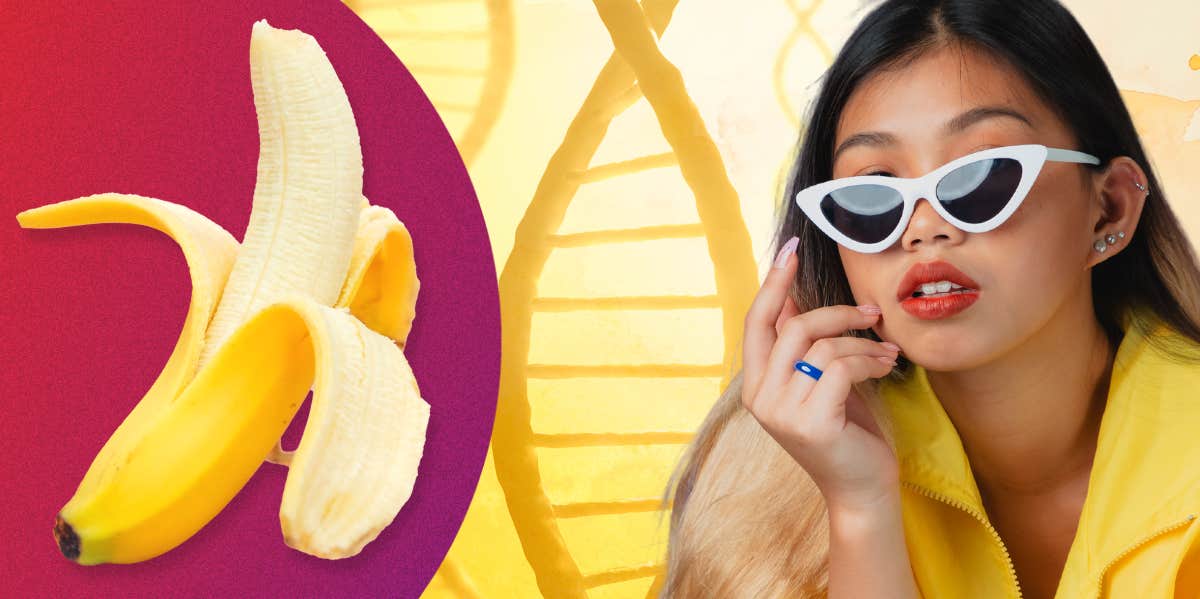Turns Out We All Share A Percent Of Our DNA With... Bananas
Are we that similar to fruit?
 DSAP Project, corelens, ktsimage / Getty Images via Canva
DSAP Project, corelens, ktsimage / Getty Images via Canva There's a theory that humans share 50% of our DNA with bananas. But is it really that crazy of a theory?
Humans share similar DNA sequences with many different species including fruits and veggies (more on that later), but the truth is that there's a misconception about that 50% and what it actually means.
The question was posed by the Human Genome Research Institute on Twitter in 2019, where they tried to break down what is really going on behind that 50% figure.
Scientists have been trying to debunk this supposed myth for a while, so let's set the record straight.
How much DNA do humans share with a banana?
When broken down, humans and bananas share 1-2% of the same DNA. That is the science.
People have continued to believe that humans and bananas share 50% of the same DNA, but that's because they have been looking at the genes, not the full DNA. What does that mean?
Well, DNA are building blocks of genes that contain the coded instruction for building and maintaining a body. The genes are a portion of that DNA that make up specific proteins that structure the body (i.e., human genes mean hair color, eye, color, skin color).
In simple terms, all genes are DNA, but not all DNA are genes.
Back to the banana-human misconception. The confusion on the topic stems from us having very similar genes or protein sequences to bananas. When looking strictly at the protein-coding genes within our DNA, we share roughly 44.1% with bananas.
However, that only covers about 1-2% of the entire DNA that we would share with a banana. Therefore, a vast majority of our DNA is different from a banana's.
Sorry to burst your bubble, but people and bananas are not closely related to each other — we just have similar amino acid sequences! We are actually much closer to chimpanzees.
How genetically similar are humans to other species?
One species that human DNA is most similar to is chimpanzees, coming in at 99%. Yes, that chimpanzee at your local zoo is our closest living relative, species-wise.
Humans share some DNA with other creatures on earth, including fruit flies, mice, cats, cows, chickens, and even lettuce. Yes, really.
The fruit fly only shares a good 60% of our DNA, mostly related to growth and development. However, it was found that approximately 75% of genes that cause disease in humans can also be found in fruit flies.
Mice are another furry creature we share DNA with, about 67% of it to be exact.
Just about all of the genes in mice share the same functions as humans. That is, we have the same kinds of organs, as well as circulatory, reproductive, digestive, hormonal, and nervous systems. We also share the same development process from sperm and egg.
We share around 90% of the same DNA with a house cat. Our genomes are very similar in that there are 20,000 protein-encoding genes and about 16,000 of them are identical to each other.
Cows are pretty highly similar as well, with about 80% DNA similarity, while chickens have 60%. But while people also believe we share 99% of our DNA with lettuce, that's a misconception, just like with bananas; in actuality, we share between 30-40% with lettuce.
Mostly, all of these species have high similarity within the protein-coding genes as well. That means that a billion years ago, we may have shared a common ancestor with several of these species!
Deauna Nunes is an associate editor for YourTango who covers pop culture, lifestyle, astrology, and relationship topics. She's had bylines in Emerson College's literary magazine, Generic and MSN.

